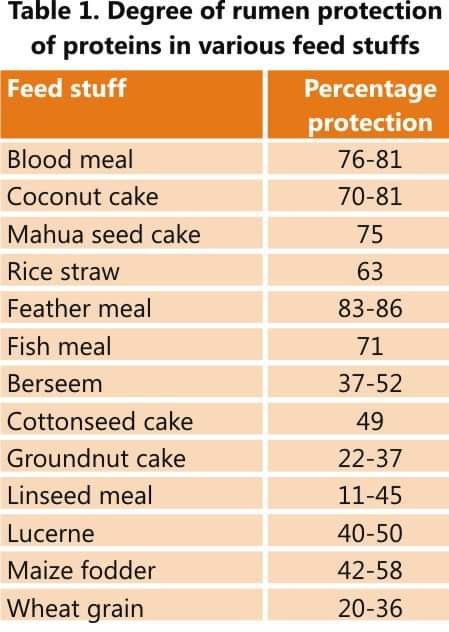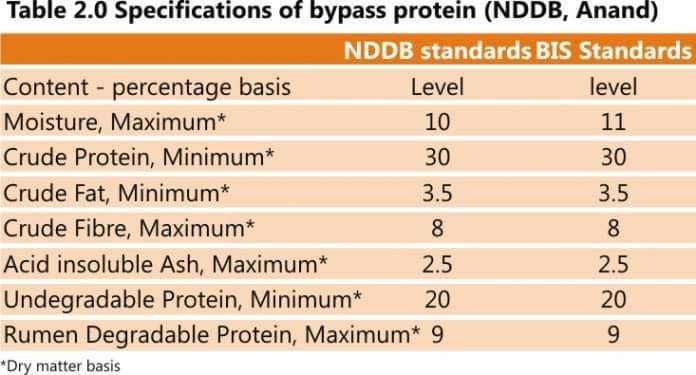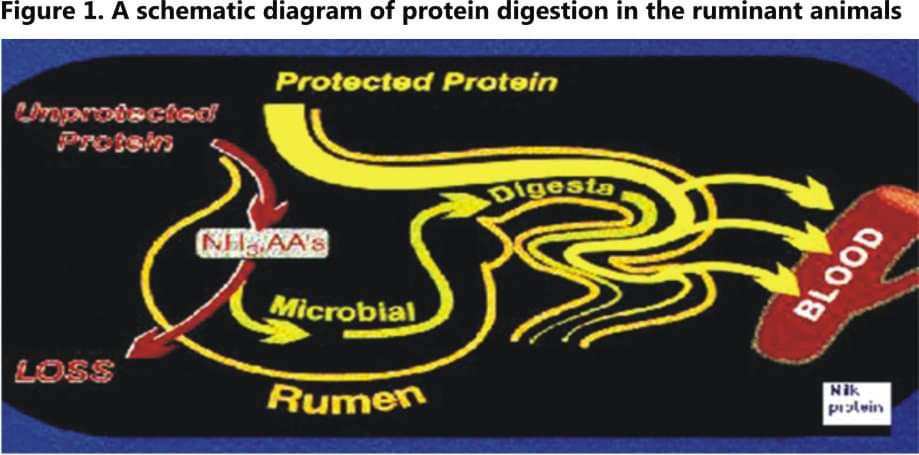USE OF BYPASS PROTEIN IN DAIRY COWS & BUFFALOES FOR MORE MILK YIELD
Dr.Chandrakiran Sant, Dairy Advisor,Pune.
Indian Dairy farmers must understand the role & importance of Bypass Protein in milk yield & maintaining better health of Dairy cattle.
India leads the world in terms of milk production. The annual milk production is 210MT while the per capita availability is only 390grams.World’s best Buffalo breeds are found in India which are major contributors of national milk pool i.e. ~52%. On comparing per capita availability of milk, India lags far behind developed countries like USA, Israel. Though we have highest number of bovines in the world, but the milk production per animal is very less. The reason being low production potential of indigenous breeds. Even the introduction of exotic milch breeds like Holstein Friesian in India failed to reach their maximum potential. Crossbreeding programe has played an important role in increasing the milk production in the country. But still, these animals need more care, improved feeding and better protection from environment.
Protein, an important constituent in ration of cattle and buffalo, when fed to ruminants is degraded by rumen microbes into ammonia, aminoacid and peptides. Subsequently, these degradable products are utilised by the microbes for microbial protein synthesis, but that process may not be always efficient. Moreover, the excess ammonia produced from the degradation of highly degradable cakes, after absorption from rumen wall is transported to liver, converted to urea and excreted out through urine. It is a mere waste of dietary proteins, plus taxing the animal’s energy which is spent on urea synthesis. Although microbial protein is a good quality protein, it may not be sufficient to meet the requirement of high milk yielding animals. So ruminants may also given proteins which are capable of escaping ruminal degradation, called undegraded dietary protein (UDP) or bypass protein, which are degraded in the intestines and absorbed as amino acids. Thus, to meet the nutritional requirements of high yielding animals, feed technologies like rumen protected proteins can be adopted as it has consistently shown not only increased milk yield, but also improved growth and reproduction.
In high yielding cattle, the output in form of milk is more than the input given i.e. feed especially during early lactation. There are multiple reasons for the imbalance, one being the less appetite which results in lesser dry matter intake after parturition while the protein and energy requirements are high during early lactation. This results in mobilization of body reserves which leads to weight loss and finally decrease in milk production. Supply of high protein in diet is not the only solution because breakdown of protein occurs in rumen by microbes. Hence, to meet its requirements, supply of bypass protein can be a good option.
Dietary proteins are mostly degraded in the rumen and transformed in microbial protein. The method to increase protein supply to the cows is termed as “bypass protein technology” . The protected protein by-passes the rumen and provides additional essential amino acids for absorption at the small intestine . Bypass protein is known to stimulate the voluntary feed intake and thereby improve milk quality and quantity and thereby increase the income from dairy cows farming .
There are several available natural bypass proteins (oilseed meal, fishmeal, cereal bran,
tannin-containing legume, corn gluten meal and cottonseed meal) are naturally less degradable in the rumen, and thereby make available in sufficient quantity in the intestine for optimum absorption . Other are soluble protein meals, their bypass protein qualities can be improved by protecting from degradation in the rumen by “protection” processes which include heat and reactions with aldehydes, such as formaldehyde and glutaraldehyde or mixing with tannins or selection of plants with tannins . It is generally presumed that bypass protein is most beneficial to high yielding cows, however, in view of the positive results obtained in several studies in India on medium producing cows, the subject needs a rethinking on the part of ruminant nutritionists. Bypass protein usually increases feed
intake and as a consequence promotes milk production. The increase in milk production may be attributed to more availability of protein for digestion in the intestine, thereby increasing the supply of precursors of milk production.


Rumen microbes break down degradable protein to small peptides, amino acids, and ammonia. These products can in turn be used by rumen microbes to produce microbial protein that can be digested by the cow in the small intestine. Microbial protein is an excellent quality protein, unfortunately not enough can be produced to supply the requirement for the high producing dairy cow. Therefore, undegradable protein must be available to make up the difference between what the cow requires and what the microbial protein supplies. Feeds vary in their ability to supply undegradable protein and quality will vary by source and depend on digestibility and amino acid composition. If the undegradable protein is indigestible or has a poor amino acid profile it will be of little value. Methionine and lysine, these two amino acids are generally considered to be first limiting for milk protein production.
BYPASS PROTEIN SUPPLEMENT PRODUCTION PROCESS
Protein is usually the first limiting nutrient for cattle and buffeloes fed low quality forages. All ruminants derive their protein requirement from two sources. One is rumen un-degraded feed protein that gets enzymatically digested in the abomasums and small intestine and another source of protein is rumen microbes. The microbial fermentation of soluble protein in the rumen is an unavoidable consequence of digestion and under many circumstances; it is a wasteful process because high quality proteins are broken down to ammonia, excess converted to urea in the liver and excreted through urine. The solubility of proteins change when subjected to special chemical treatment, advantage of which is to protect good quality proteins from rumen degradation (Fig. 4.1). Number of chemicals like acetaldehyde, formaldehyde, glutaraldehyde, ethanol, tannic acid, acetic acid, sodium hydroxide etc. have been tried to protect proteins. Amongst all, aldehyde suggested for protection of protein, formaldehyde has been extensively used for production of bypass protein feed.
Usually, protein meals are fed to ruminants in India, which have variable degree of naturally rumen protected proteins. Protein meals, particularly rumen escape proteins, play a very important role as excellent protein supplement, in livestock feeding. When these meals are fed as such to ruminants, about 70 per cent of the protein is broken down to ammonia by the rumen microbes in the rumen and a significant portion is converted to urea in liver and excreted in the form of urea through urine. However, if these protein meals are subjected to suitable chemical treatment, then their efficiency of utilization can be significantly improved. When chemically treated protein meals replace untreated one, then due to less degradability of the protein in the rumen, excessive loss of both nitrogen and energy could be avoided, resulting in an increased energy and nitrogen balance, leading to increase in milk yield and milk constituents. Bypass protein feed is a new generation cattle feed in India and is manufactured by a special chemical treatment, developed by the National Dairy Development Board (NDDB). Bypass protein feed contains a large percentage of solvent extracted protein meals in treated form, grain by-products, whole grains, molasses, minerals and vitamins. The special feature of the formulation is that more than 70 per cent of the total protein in the feed is rumen undegradable protein.
Characteristics considered desirable for protected protein supplements
• High level of crude protein.
• Optimal essential amino acids profile.
• About 70-75 per cent of the protein to be in a rumen un-degradable form (UDP).
• Approximately 80 per cent of the rumen un-degradable protein to be digestible in the small intestine.
Benefits of feeding bypass protein feed
• Increase in efficiency of utilization of proteins.
• Increase in availability of essential amino acids.
• Increase the supply of limiting amino acids like lysine and methionine to the small intestine.
• Improvement in milk production.
• Improvement in fat and SNF per cent.
• Better growth in young animals.
• Easier to meet the requirement of high yielding animals.
• Improvement in reproduction efficiency.
• Better resistance against diseases.
• Helps in increasing net daily income.
• Helps to control Salmonella and reduce mould growth in feedstuffs.
Inclusion of bypass protein in diet of milch animals has a great potential of increasing milk production in developing countries. Komagiri and Erdman (1992) reported that there was increase in milk production in HF cows that were supplemented with increased levels of rumen undegradable protein. Due to negative energy balance, dairy cows may show longer service period as they suffer from nutritional infertility.
Bypass protein is an important source for meeting requirements of high yielding animals but better results can be obtained when dietary protein has degradable and bypass protein in the ratio of 40:60. The rumen degradability of proteins can be artificially prevented by treating the protein sources in such a way to decrease its availability for the rumen microbes. The easiest and most common method is heat and formaldehyde treatment. According to Gulati et al. (2001) bypass protein supplements for dairy cow should contain high level of crude protein, optimum essential amino acid profile, 70-80% rumen undegradable protein with near about 80% of digestibility in small intestines.
As discussed earlier, there is some degree of natural protection of feeds. Further, proteins can be artificially protected from ruminal degradation by following methods:
a. Chemical protection
Proteins are chemically protected by treating with substances like tannins, formaldehyde, glutaraldehyde, glyoxal and hexa-methylenetetramine. But formaldehyde treatment is most commonly used. Formaldehyde treatment has been found effective in improving the bypass protein in oilseed meals, hay and silage. 0.5-1.5, 1-3 and 3-5% formaldehyde is used for protein protection in concentrates, hay and silage respectively. Formaldehyde treatment not only increases the rumen undegradable protein in feed stuffs but also increases its acceptability by animals.
Treating protein meals with formaldehyde has the following advantages
- Desired level of protein protection can be achieved
- Under and over protection of proteins can be eliminated
- The bio-availability of the essential amino acids can be maximized
- It does not increase the proportion of ADIN and NDIN contents
- Economical
- The HCHO treatment of groundnut cake arrests further growth of fungi and thus production of mycotoxins in the cake. b. Heat treatment
Heat treatment to feed stuffs has been found to increase the protein protection. It works on the principle that heat treatment causes denaturation of proteins which provides effective protection against microbial attack. Heat treatment at higher temperatures reduces the availability of some amino acids like cystine, arginine so to reduce such losses, steam treatment has been found fruitful. Steam treatment increases both bypassability and digestibility of proteins. However, heat treatment is much costlier and economically not viable.
Conclusions
High yielding dairy animals have high nutritional requirement. During early lactation, if the dietary intake is less than the milk production, they can reach negative energy balance. Feeding of bypass proteins is one of the best methods to meet these requirements. As it directly reach the small intestines escaping the rumen degradation and is available to meet high protein demands of animal. Bypass proteins will also help to maintain normal fertility. Hence, the farmers are advised to adopt mentioned feeding strategies for maximum benefits.
Reference-On Request.


